Chien-Yu Lin
Hybrid Architectures for Language Models: Systematic Analysis and Design Insights
Oct 06, 2025Abstract:Recent progress in large language models demonstrates that hybrid architectures--combining self-attention mechanisms with structured state space models like Mamba--can achieve a compelling balance between modeling quality and computational efficiency, particularly for long-context tasks. While these hybrid models show promising performance, systematic comparisons of hybridization strategies and analyses on the key factors behind their effectiveness have not been clearly shared to the community. In this work, we present a holistic evaluation of hybrid architectures based on inter-layer (sequential) or intra-layer (parallel) fusion. We evaluate these designs from a variety of perspectives: language modeling performance, long-context capabilities, scaling analysis, and training and inference efficiency. By investigating the core characteristics of their computational primitive, we identify the most critical elements for each hybridization strategy and further propose optimal design recipes for both hybrid models. Our comprehensive analysis provides practical guidance and valuable insights for developing hybrid language models, facilitating the optimization of architectural configurations.
xKV: Cross-Layer SVD for KV-Cache Compression
Mar 24, 2025Abstract:Large Language Models (LLMs) with long context windows enable powerful applications but come at the cost of high memory consumption to store the Key and Value states (KV-Cache). Recent studies attempted to merge KV-cache from multiple layers into shared representations, yet these approaches either require expensive pretraining or rely on assumptions of high per-token cosine similarity across layers which generally does not hold in practice. We find that the dominant singular vectors are remarkably well-aligned across multiple layers of the KV-Cache. Exploiting this insight, we propose xKV, a simple post-training method that applies Singular Value Decomposition (SVD) on the KV-Cache of grouped layers. xKV consolidates the KV-Cache of multiple layers into a shared low-rank subspace, significantly reducing KV-Cache sizes. Through extensive evaluations on the RULER long-context benchmark with widely-used LLMs (e.g., Llama-3.1 and Qwen2.5), xKV achieves up to 6.8x higher compression rates than state-of-the-art inter-layer technique while improving accuracy by 2.7%. Moreover, xKV is compatible with the emerging Multi-Head Latent Attention (MLA) (e.g., DeepSeek-Coder-V2), yielding a notable 3x compression rates on coding tasks without performance degradation. These results highlight xKV's strong capability and versatility in addressing memory bottlenecks for long-context LLM inference. Our code is publicly available at: https://github.com/abdelfattah-lab/xKV.
TeleRAG: Efficient Retrieval-Augmented Generation Inference with Lookahead Retrieval
Feb 28, 2025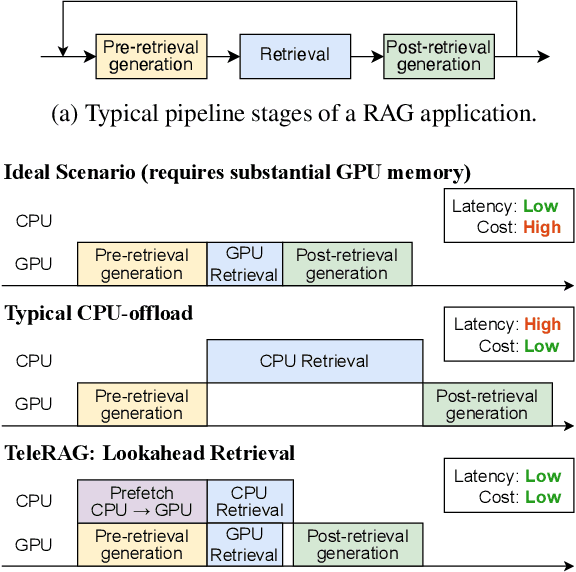



Abstract:Retrieval-augmented generation (RAG) extends large language models (LLMs) with external data sources to enhance factual correctness and domain coverage. Modern RAG pipelines rely on large datastores, leading to system challenges in latency-sensitive deployments, especially when limited GPU memory is available. To address these challenges, we propose TeleRAG, an efficient inference system that reduces RAG latency with minimal GPU memory requirements. The core innovation of TeleRAG is lookahead retrieval, a prefetching mechanism that anticipates required data and transfers it from CPU to GPU in parallel with LLM generation. By leveraging the modularity of RAG pipelines, the inverted file index (IVF) search algorithm and similarities between queries, TeleRAG optimally overlaps data movement and computation. Experimental results show that TeleRAG reduces end-to-end RAG inference latency by up to 1.72x on average compared to state-of-the-art systems, enabling faster, more memory-efficient deployments of advanced RAG applications.
Palu: Compressing KV-Cache with Low-Rank Projection
Jul 30, 2024



Abstract:KV-Cache compression methods generally sample a KV-Cache of effectual tokens or quantize it into lower bits. However, these methods cannot exploit the redundancy of the hidden dimension of KV tensors. This paper investigates a unique hidden dimension approach called Palu, a novel KV-Cache compression framework that utilizes low-rank projection. Palu decomposes the linear layers into low-rank matrices, caches the smaller intermediate states, and reconstructs the full keys and values on the fly. To improve accuracy, compression rate, and efficiency, Palu further encompasses (1) a medium-grained low-rank decomposition scheme, (2) an efficient rank search algorithm, (3) a low-rank-aware quantization algorithm, and (4) matrix fusion with optimized GPU kernels. Our extensive experiments with popular LLMs show that Palu can compress KV-Cache by more than 91.25% while maintaining a significantly better accuracy (up to 1.19 lower perplexity) than state-of-the-art KV-Cache quantization methods at a similar or even higher memory usage. When compressing KV-Cache for 50%, Palu delivers up to 1.61x end-to-end speedup for the attention module. Our code is publicly available at https://github.com/shadowpa0327/Palu.
Encode Once and Decode in Parallel: Efficient Transformer Decoding
Mar 19, 2024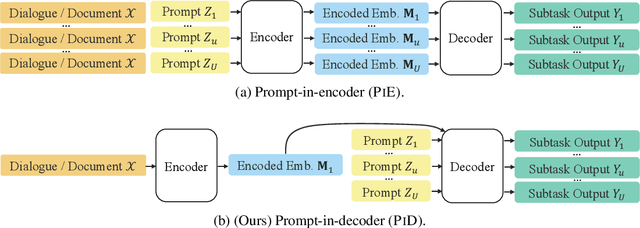


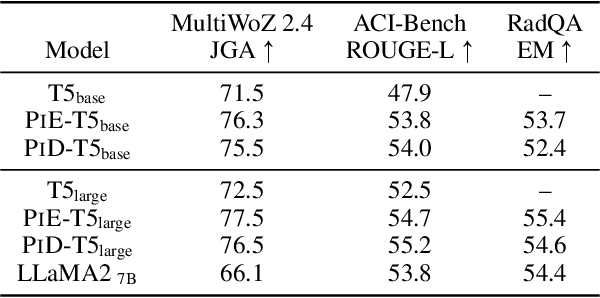
Abstract:Transformer-based NLP models are powerful but have high computational costs that limit deployment scenarios. Finetuned encoder-decoder models are popular in specialized domains and can outperform larger more generalized decoder-only models, such as GPT-4. We introduce a new configuration for encoder-decoder models that improves efficiency on structured output and question-answering tasks where multiple outputs are required of a single input. Our method, prompt-in-decoder (PiD), encodes the input once and decodes output in parallel, boosting both training and inference efficiency by avoiding duplicate input encoding, thereby reducing the decoder's memory footprint. We achieve computation reduction that roughly scales with the number of subtasks, gaining up to 4.6x speed-up over state-of-the-art models for dialogue state tracking, summarization, and question-answering tasks with comparable or better performance. We release our training/inference code and checkpoints.
FastSR-NeRF: Improving NeRF Efficiency on Consumer Devices with A Simple Super-Resolution Pipeline
Dec 20, 2023



Abstract:Super-resolution (SR) techniques have recently been proposed to upscale the outputs of neural radiance fields (NeRF) and generate high-quality images with enhanced inference speeds. However, existing NeRF+SR methods increase training overhead by using extra input features, loss functions, and/or expensive training procedures such as knowledge distillation. In this paper, we aim to leverage SR for efficiency gains without costly training or architectural changes. Specifically, we build a simple NeRF+SR pipeline that directly combines existing modules, and we propose a lightweight augmentation technique, random patch sampling, for training. Compared to existing NeRF+SR methods, our pipeline mitigates the SR computing overhead and can be trained up to 23x faster, making it feasible to run on consumer devices such as the Apple MacBook. Experiments show our pipeline can upscale NeRF outputs by 2-4x while maintaining high quality, increasing inference speeds by up to 18x on an NVIDIA V100 GPU and 12.8x on an M1 Pro chip. We conclude that SR can be a simple but effective technique for improving the efficiency of NeRF models for consumer devices.
Atom: Low-bit Quantization for Efficient and Accurate LLM Serving
Nov 07, 2023



Abstract:The growing demand for Large Language Models (LLMs) in applications such as content generation, intelligent chatbots, and sentiment analysis poses considerable challenges for LLM service providers. To efficiently use GPU resources and boost throughput, batching multiple requests has emerged as a popular paradigm; to further speed up batching, LLM quantization techniques reduce memory consumption and increase computing capacity. However, prevalent quantization schemes (e.g., 8-bit weight-activation quantization) cannot fully leverage the capabilities of modern GPUs, such as 4-bit integer operators, resulting in sub-optimal performance. To maximize LLMs' serving throughput, we introduce Atom, a low-bit quantization method that achieves high throughput improvements with negligible accuracy loss. Atom significantly boosts serving throughput by using low-bit operators and considerably reduces memory consumption via low-bit quantization. It attains high accuracy by applying a novel mixed-precision and fine-grained quantization process. We evaluate Atom on 4-bit weight-activation quantization setups in the serving context. Atom improves end-to-end throughput by up to $7.73\times$ compared to the FP16 and by $2.53\times$ compared to INT8 quantization, while maintaining the same latency target.
SPIN: An Empirical Evaluation on Sharing Parameters of Isotropic Networks
Jul 21, 2022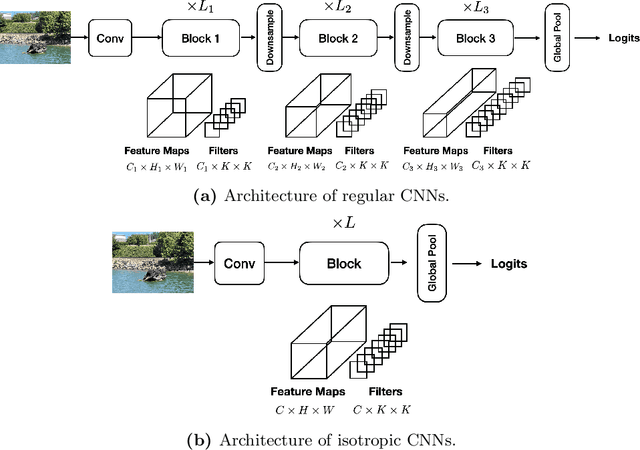
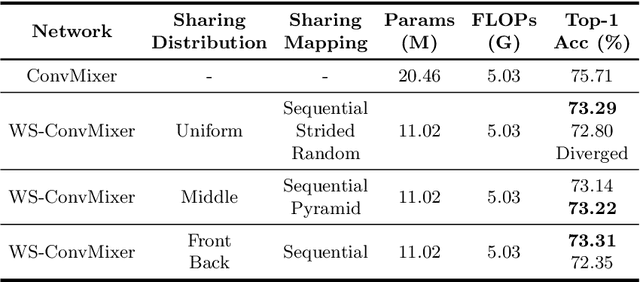
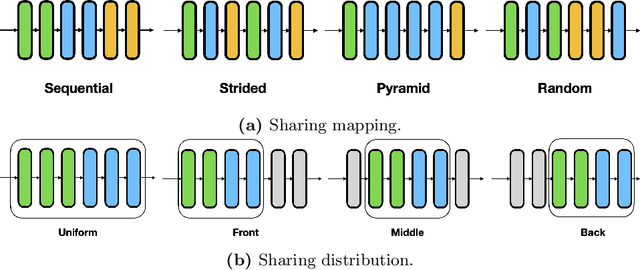

Abstract:Recent isotropic networks, such as ConvMixer and vision transformers, have found significant success across visual recognition tasks, matching or outperforming non-isotropic convolutional neural networks (CNNs). Isotropic architectures are particularly well-suited to cross-layer weight sharing, an effective neural network compression technique. In this paper, we perform an empirical evaluation on methods for sharing parameters in isotropic networks (SPIN). We present a framework to formalize major weight sharing design decisions and perform a comprehensive empirical evaluation of this design space. Guided by our experimental results, we propose a weight sharing strategy to generate a family of models with better overall efficiency, in terms of FLOPs and parameters versus accuracy, compared to traditional scaling methods alone, for example compressing ConvMixer by 1.9x while improving accuracy on ImageNet. Finally, we perform a qualitative study to further understand the behavior of weight sharing in isotropic architectures. The code is available at https://github.com/apple/ml-spin.
Comprehensive and Clinically Accurate Head and Neck Organs at Risk Delineation via Stratified Deep Learning: A Large-scale Multi-Institutional Study
Nov 01, 2021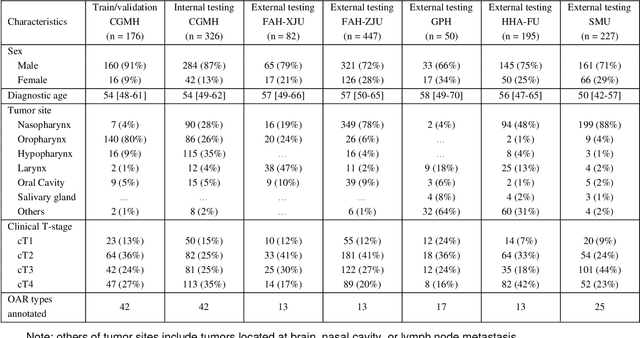
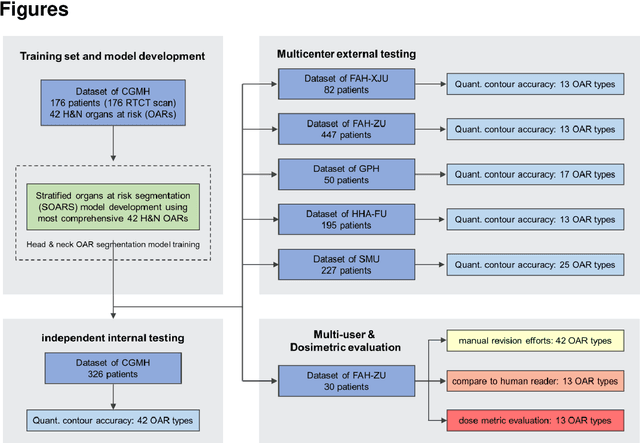

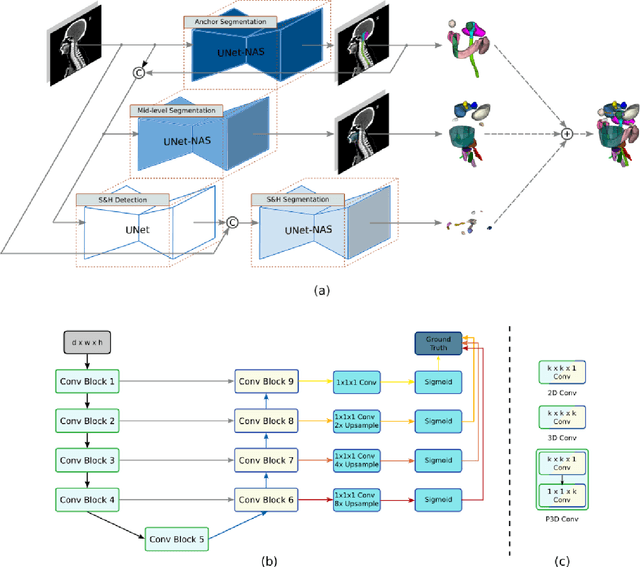
Abstract:Accurate organ at risk (OAR) segmentation is critical to reduce the radiotherapy post-treatment complications. Consensus guidelines recommend a set of more than 40 OARs in the head and neck (H&N) region, however, due to the predictable prohibitive labor-cost of this task, most institutions choose a substantially simplified protocol by delineating a smaller subset of OARs and neglecting the dose distributions associated with other OARs. In this work we propose a novel, automated and highly effective stratified OAR segmentation (SOARS) system using deep learning to precisely delineate a comprehensive set of 42 H&N OARs. SOARS stratifies 42 OARs into anchor, mid-level, and small & hard subcategories, with specifically derived neural network architectures for each category by neural architecture search (NAS) principles. We built SOARS models using 176 training patients in an internal institution and independently evaluated on 1327 external patients across six different institutions. It consistently outperformed other state-of-the-art methods by at least 3-5% in Dice score for each institutional evaluation (up to 36% relative error reduction in other metrics). More importantly, extensive multi-user studies evidently demonstrated that 98% of the SOARS predictions need only very minor or no revisions for direct clinical acceptance (saving 90% radiation oncologists workload), and their segmentation and dosimetric accuracy are within or smaller than the inter-user variation. These findings confirmed the strong clinical applicability of SOARS for the OAR delineation process in H&N cancer radiotherapy workflows, with improved efficiency, comprehensiveness, and quality.
Accelerating SpMM Kernel with Cache-First Edge Sampling for Graph Neural Networks
Apr 23, 2021



Abstract:Graph neural networks (GNNs), an emerging deep learning model class, can extract meaningful representations from highly expressive graph-structured data and are therefore gaining popularity for wider ranges of applications. However, current GNNs suffer from the poor performance of their sparse-dense matrix multiplication (SpMM) operator, even when using powerful GPUs. Our analysis shows that 95% of the inference time could be spent on SpMM when running popular GNN models on NVIDIA's advanced V100 GPU. Such SpMM performance bottleneck hinders GNNs' applicability to large-scale problems or the development of more sophisticated GNN models. To address this inference time bottleneck, we introduce ES-SpMM, a cache-first edge sampling mechanism and codesigned SpMM kernel. ES-SpMM uses edge sampling to downsize the graph to fit into GPU's shared memory. It thus reduces the computation cost and improves SpMM's cache locality. To evaluate ES-SpMM's performance, we integrated it with a popular GNN framework, DGL, and tested it using representative GNN models and datasets. Our results show that ES-SpMM outperforms the highly optimized cuSPARSE SpMM kernel by up to 4.35x with no accuracy loss and by 45.3x with less than a 1% accuracy loss.
 Add to Chrome
Add to Chrome Add to Firefox
Add to Firefox Add to Edge
Add to Edge